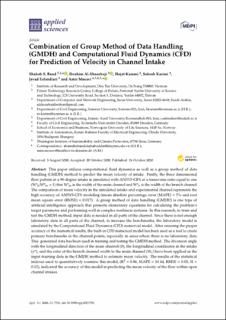| dc.description.abstract | This paper utilizes computational fluid dynamics as well as a group method of data handling (GMDH) method to predict the mean velocity of intake. Firstly, the three dimensional flow pattern in a 90-degree intake is simulated with ANSYS-CFX at a transverse ratio equal to one (W*b/W*m = 1) that W*m is the width of the main channel and W*b is the width of the branch channel. The comparison of mean velocity in the simulated intake and experimental channel represents the high accuracy of ANSYS-CFX modeling (mean absolute percentage error (MAPE) = 5% and root mean square error (RMSE) = 0.017). A group method of data handling (GMDH) is one type of artificial intelligence approach that presents elementary equations for calculating the problem’s target parameter and performing well in complex nonlinear systems. In this research, to train and test the GMDH method, input data is needed in all parts of the channel. Since there is not enough laboratory data in all parts of the channel, to increase the benchmarks, the laboratory model is simulated by the Computational Fluid Dynamics (CFD) numerical model. After ensuring the proper accuracy of the numerical results, the built-in CFD numerical model has been used as a tool to create primary benchmarks in the channel points, especially in areas where there is no laboratory data. This generated data has been used in training and testing the GMDH method. The diversion angle with the longitudinal direction of the main channel (θ), the longitudinal coordinates in the intake (y*), and the ratio of the branch channel width to the main channel (Wr) have been applied as the input training data in the GMDH method to estimate mean velocity. The results of the statistical indexes used to quantitatively examine this model, (R2 = 0.86, MAPE = 10.44, RMSE = 0.03, SI = 0.12), indicated the accuracy of this model in predicting the mean velocity of the flow within open channel intakes. | en_US |

